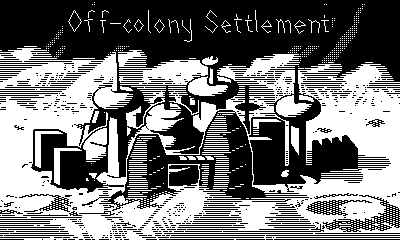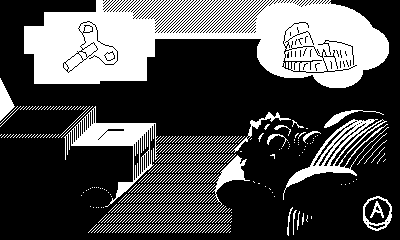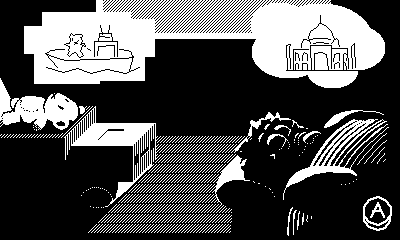Mars After Midnight
A gloriously weird "happy dad" game
Playdate
$6
Lucas Pope
4 hours
Mars After Midnight is a puzzle game where you run a community support centre. Your job is to admit the right Martians (e.g. non-farters should be kept out of the “Farty Party”), tidy the refreshments table, and put up posters for upcoming sessions.
It’s tempting to call Mars After Midnight a game for kids, especially when the designer, Lucas Pope, says:
It's my usual repetitive isnt-this-just-work bs, only more carefree. I made it for my kids, who claim to "love it", as is their obligation.
But there are kids games and there are kids games. Is Tetris a kids game? Is My Neighbor Totoro a kids movie? Adults love them no less than kids. There’s a level of artistry and care to them that can be appreciated by all ages. I wouldn’t put Mars After Midnight quite in their ranks – it overstays its welcome just a smidge – but it’s funny and witty, approachable and absurd, silly and caring. That’s no easy balance.
We begin with a view of the Martian landscape speeding by: first, the Earth Colony, then some distance away, the Off-colony Settlement. A clock ticks the seconds to midnight, and a shop’s sign flickers from “Airtight Shipping and Receiving” to “Off-colony Community Support Center”.
Tonight’s session is for Cyclops Anger Management. A note taped up on the inside of the door’s shutter indicates that no-one with two eyes or anyone smiling should be admitted.
Someone knocks. To lift the shutter, you turn the Playdate console’s physical crank. An angry cyclops? Hold the A button to let them inside. Anyone other than an angry cyclops? Crank down the shutter. Sometime you’ll need to peer from side to side to check if an alien really does have only one eye, or if it’s just a chancer looking for a free snack.
That’s because Martians pass by your refreshments table on their way to the meeting room. If they decide to have a bite, they often make a mess which needs tidying up lest subsequent Martians get grossed out and don’t leave a two credit tip.
Tidying is basically a Tower of Hanoi puzzle where you rearrange stacks of dishes and utensils to how they were laid out before, as indicated by a poster. The only complication is that you also need to sweep the table of crumbs using the satisfyingly crank-operated “Soup-A Sweep-A”, which requires lifting everything up on your two tentacles. It’s surprising how well this works with the Playdate’s limited controls; you can lift from any object in a stack, move and drop stacks independently, and it never feels confusing.
There’s zero time pressure, though the constant door knocking from eager Martians can be hard to ignore, and the worst thing that can happen if you don’t tidy up is that a Martian won’t leave a tip, which ultimately makes no difference whatsoever, gameplay-wise.
Back at the door, you admit more Martians. It’s never not funny to crank up the shutter, see someone who is plainly not suitable (e.g. they have six eyes) and slam it down, usually to forlorn mews. They’ll be fine!
When the session is at its six-person capacity, you clear the refreshment table by feeding everything into a big vacuum tube, then watch as your robot partner plays the Cyclops Anger Management session tape and the Martians dance around it. I have no idea what is meant to be happening here, but it looks fun!
Interestingly, you don’t know whether you’ve admitted the “right” Martians until the session concludes and give two credits to indicate whether they found it helpful. This is just one of the ways the game tries to make you feel OK about discriminating between Martians, the idea being that sessions have a limited capacity and it’s better if you let in those whom your help is designed for. It worked for me but I can imagine others feeling a bit uncomfortable.
What if someone doesn’t find the session helpful because they weren’t (in this case) an angry cyclops? Nothing bad – you’ll just need to run the session again at some point for the angry cyclopses you missed. And you might still have gotten a tip from the non-cyclops for your refreshments.
After they leave, the Martians spread out across a map of the settlement and you see a message: “114 Martians still need help”, represented by flashing dots. This is the beginning of the planning phase, where you decide on three things for the next day:
Choose a session topic, like Shy Smiler Mixer, Cracked Skull Crew, Wind-Proof Warriors, Gnat Knife Handling, and so on (more on these later). Each topic highlights where its six attendees live in, which doesn’t really matter but kind of looks cool. Some sessions require an accessory – Gnat Knife Handling needs a five credit Zoom Lens, as does one about clogged pores. Other sessions are locked until you buy the required session tape (ditto).
Place posters where the attendees live. They can go in distinct regions across the settlement, each of which costs a different amount to poster. At the start of the game I assumed there was some strategy in picking sessions where attendees were clustered in regions where postering was cheaper, but you soon have more money than you need so it’s really just a bit of busywork.
Pick a refreshment. These also cost money (e.g. Wugwiches and Dune Bug Pie are both 3 credits) and are more popular in some areas of the settlement than others, but apparently your choice of refreshment has no effect on who visits.
Once everything’s decided, you pay for your selections and head to your empty apartment with your robot friend. You dream of famous places on Earth like Big Ben, Stonehenge, and the Colosseum, and your robot dreams of repair parts, snakes, and nuts and bolts. It is unbearably sweet:
Planning and running a session takes a little under ten minutes, which you’ll do around 25 to 30 times. The speedy rounds and the game’s forgiving nature, with its complete lack of fail state, permits a surprising level of ambiguity. One of my early sessions was the Non-blinker Roundtable; a picture showed a Martian with two eyes, so I wasn’t sure if I could let in three-eyed non-blinkers. It turned out this was fine, but I didn’t feel too anxious about being punished, and in the end, I only misidentified three Martians out of more than 200.
In my book critiquing gamification, I note that many of our most beloved games are completely devoid of achievements, levels, badges, and challenges. The same is true of Mars After Midnight, which has none of them. There’s no grinding, either – as soon as you’ve mastered one session’s gimmick, like using X-Ray glasses to let in vampires, you’re onto the next.
The one time when things begin to drag – when you’ve let in four or five Martians and it’s getting too easy to tell who’s got clogged pores – is when the sketchy-looking Sherb turns up. He’ll sell you one item a day, including:
Tapes that unlock new sessions
Expensive recipes (15 credits for Chorbfish? You’re havin’ a larf, mate!)
An almost entirely superfluous but amusing Blab-o-dex translator
A transit pass for a ticket to the Earth Colony, which costs an eye-watering 100,000 credits and is obviously the game’s goal.
You’ll end up buying everything, even the outrageously expensive Chorbfish recipe, just to see what happens; of course, everyone thinks it’s delicious and it’s more fun to arrange than other refreshments.
An Incomplete List of Sessions
Clogged Pore Clinic: Use a zoom lens to see which Martians have clogged pores. This was tricky at the start – what does a Martian clogged pore look like?
Math Olympics: Hold up a calculator showing sums for Martians to answer correctly. Usually they give comically bad answers; to “92 + 98” one alien answered “3” (adding “for sure”). Another, when asked “0 x 6” lamely said “no idea”.
Flinching Fellowship: Toot a horn; if the Martian doesn’t flinch, slam that shutter down!
Boxing Brush Up: Fire a boxing glove to see if Martians can successfully dodge; if they get hit, no entry. I tried to punch Sherb’s delivery robot once – of course, it dodged.
Gnat Knife Handling: Only let in gnats bearing knives! Naturally, you need the zoom lens:
Farty Party: Just listen for the extremely loud farts!
Shy Smiler Mixer: These Martians will only smile when the shutter is half-closed and you can’t see their eyes. This requires more delicate crank operation than usual, along with peering up and down the window – tricky.
E.S.P. 1 2 3: Test whether Martians can successfully read symbols from hidden cards. You need the translator for this!
In a recent post on Sunset, I suggested that polish is overrated. Lucas Pope evidently disagrees because this is one of the tightest, most polished games I’ve played in a long time. But as in his other games, his polish is more like the sheen of a handcrafted chair rather than that of a mass-produced SUV. Mars After Midnight has idiosyncrasies and ambiguity to spare, to the point where sometimes it’s unclear what you’re meant to be doing, but it’s all clearly on purpose.
The polish covers every surface of the chair, even the underside. Every alien, robot, and human is hand-drawn in weird, organic forms reminiscent of Daniel Mróz’s sci-fi illustrations for Stanislaw Lem. Voices are heavily distorted English that you eventually recognise by the end of the game. When there isn’t a Martian to admit, you can see hovercars whizzing buy, aliens slithering around, and people shouting things to each other from windows like “lovely weather!” and “terrible weather!” There’s the sly, nervous look your character has when a Martian finishes eating and hopes for a tip.
And then there’s your adorable robot, a friend as well as a business partner. Every session begins with you slamming the session tape into its top, which feels very satisfying until you mistime it and it cringes the next time you try. Martians deposit credits in slots on the robot’s side; the robot runs sessions and helps you plan them.
After a while, it dreams of a teddy bear, night after night. Sherb turns up, offering to sell you one for 15 credits – steep, but of course you pay it. The next night, the teddy bear is sitting on top of the robot’s chest as it dreams of being in a boat with its bear:
When there’s only a few Martians left to help in the settlement, Sherb gifts you a transit pass to the Earth Colony. Why not after you’ve cleared it? To establish that your goal is not, in fact, to get to Earth as soon as possible, but to help as many people as you can.
The Earth Colony is essentially a bonus level. There’s only 24 people to help with weirder refreshments and sessions (e.g. detecting Martians secretly posing as humans). Sherb gifts you an even more expensive ticket off Mars, but this time he can’t join you on the rocket. As you approach Earth, the game ends with a message: 8.2 billion Earthlings need help.
It is often said that designers make “sad dad” games after they have children, a joke that has more than a little truth. God of War, The Last of Us, The Walking Dead – they all linger on the fragility of life, a tragically missing mother, the sacrifices a man must make for his child, and so on.
So what does Lucas Pope do after he has kids? He makes a game where you honk a horn at aliens and clean up after their mess. Let’s call it a happy dad game.
This post marks the one year anniversary of Have You Played! It’s a good moment to slow my pace so I have time to write other things, as well as move to my old blog.
More details next week, in my final roundup post from Substack!















I've not anything really intelligent to say other than that this looks cute and heck and is probably the biggest sell for the Playdate I've seen so far.
Those graphics are giving me super nostalgia for early Mac gaming and making graphics in MacPaint.